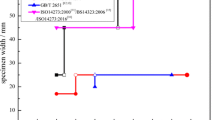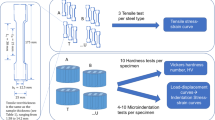Abstract
Tensile tests have been widely used to determine basic mechanical properties of materials. However, the properties measured may be related to geometrical factors of the tested samples especially for high-strength steels; this makes the properties’ definitions and comparisons difficult. In this study, a series of tensile tests of ultra-high-strength hot-stamped steel were performed; the geometric shapes and sizes as well as the cutting direction were modified. The results demonstrate that the hot-stamped parts were isotropic and the cutting direction had no effect; the measured strengths were practically unrelated to the specimen geometries, including both size and shape. The elongations were slightly related to sample sizes within the studied range but highly depended on the sample shape, represented by the coefficient K. Such phenomena were analyzed and discussed based on microstructural observations and fracture morphologies. Moreover, two widely used elongation conversion equations, the Oliver formula and Barba’s law, were introduced to verify their applicability, and a new interpolating function was developed and compared.












Similar content being viewed by others
References
Standardization Administration of the People’s Republic of China, Metallic materials-Tensile testing-Part 1: Method of test at room temperature. GB/T 228.1-2010, Standards Press of China (2010)
A.V. Sergueeva, J. Zhou, B.E. Meacham, and D.J. Branagan, Gage Length and Sample Size Effect on Measured Properties During Tensile Testing, Mater. Sci. Eng. A, 2009, 526, p 79–83
Y.H. Zhao, Y.Z. Guo, Q. Wei, T.D. Top**, A.M. Dangelewicz, Y.T. Zhu, T.G. Langdon, and E.J. Lavernia, Influence of Specimen Dimensions and Strain Measurement Methods on Tensile Stress–Strain Curves, Mater. Sci. Eng. A, 2009, 525, p 68–77
W.J. Yuan, Z.L. Zhang, Y.J. Su, L.J. Qiao, and W.Y. Chu, Influence of Specimen Thickness with Rectangular Cross-Section on the Tensile Properties of Structural Steels, Mater. Sci. Eng. A, 2012, 532, p 601–605
X. Sun, A. Soulami, K.S. Choi, O. Guzman, and W. Chen, Effects of Sample Geometry and Loading Rate on Tensile Ductility of TRIP800 Steel, Mater. Sci. Eng. A, 2012, 541, p 1–7
D.A. Oliver, Proposed New Criteria of Ductility from a New Law Connecting the Percentage Elongation with Size of Test-Piece, Proc. Inst. Mech. Eng., 1928, 2, p 827–864
X.Q. Xu and Z.W. Niu, The type, definition and conversion of elongation. in National Steel Deep-Processing Seminars, 26–27 May 2014 (The Chinese Society for Metals, Tian**, 2014)
Standardization Administration of the People’s Republic of China, Steel—Conversion of elongation values. GBT 17600.1/2-1998, Standards Press of China (1998)
L.D. Li, M. Zhao, N. Xu, X.F. Wu, J.B. Shi, and L.L. Zhang, Conversion of Percentage Elongation after Fracture of 1Cr18Ni9Ti Austenitic Stainless Steel Sheet, PTCA, 2011, 47, p 748–755 ((in Chinese))
X.F. Jia and M.H. Wei, Relationship Between Elongation After Fracture and Sample Size of Hot-Rolled Carbon Steel and Computer-Aided Analysis, Found Technol, 2015, 36, p 1961–1963 ((in Chinese))
Y.H. Zhao, Y.Z. Guo, Q. Wei, A.M. Dangelewicz, C. Xu, Y.T. Zhu, T.G. Langdon, Y.Z. Zhou, and E.J. Lavernia, Influence of Specimen Dimensions on the Tensile Behavior of Ultrafine-Grained Cu, Scripta Mater., 2008, 59, p 627–630
F. Wang, Discussion on the application of Olive Elongation Conversion Expression in Austenitic Stainless Steel 304 Foil, Met. Phys. Exam. Test, 2015, 33, p 17–20 ((in Chinese))
H. Karbasian and A.E. Tekkaya, A Review on Hot Stam**, J. Mater. Process. Technol., 2010, 210, p 2103–2118
X.H. Han, Y.Y. Zhong, P.S. ** Process. J. Eng. Manuf., 2017, 231, p 1972–1982
N. Li, C. Sun, N. Guo, M. Mohamed, J.G. Lin, T. Matsumoto, and C. Liu, Experimental Investigation of Boron Steel at Hot Stam** Conditions, J. Mater. Process. Technol., 2016, 228, p 2–10
G.M. Cola, Jr., B. Hanhold, T. Lolla, B. Radhakrishnan, and S. Babu, On the Total elongation of Advanced High-Strength Steels, Iron Steel Technol., 2013, 10, p 1–7
D.N. Hanlon, S.M.C. van Bohemen, and S. Celotto, Critical Assessment 10: Total Elongation of Strong Automotive Steels as Function of Test Piece Geometry, Mater. Sci. Technol., 2015, 31, p 385–388
E.D. Moor, Paul J. Gibbs, John G. Speer, and D.K. Matlock, Strategies for Third-Generation Advanced High-Strength Steel Development, Iron Steel Technol., 2010, 7, p 133–144
X.H. Han, K. Yang, S.S. Chen, and J. Chen, Fracture Profile and Crack Propagation of Ultra-High Strength Hot-Stamped Boron Steel During Mechanical Trimming Process, J. Mater. Eng. Perform., 2015, 24, p 3845–3851
M. Geiger, F. Vollertsen, and R. Kals, Fundamentals on the Manufacturing of Sheet Metal Microparts, CIRP Ann. Manuf. Technol., 1996, 45, p 277–282
P. Li, B. Zhao, and K.M. Xue, Mechanical Properties of Copper Alloy During Micro-Plastic Forming and Its Constitutive Model, Acta Mech Solid Sin, 2015, 36, p 401–409
C. Löbbe, O. Hering, L. Hiegemann, and A.E. Tekkaya, Setting Mechanical Properties of High Strength Steels for Rapid Hot Forming Processes, Materials, 2016, 9, p 1–19
Rahmatollah Ghajar, Giuseppe Mirone, and Arash Keshavarz, Ductile Failure of X100 Pipeline Steel—Experiments and Fractography, Mater. Des., 2013, 43, p 513–525
American Society for Metals, Metals Handbook Vol11: Failure Analysis and Prevention, 10th ed., W.T. Becker and R.J. Shipley, Ed., ASM International, Russell, 2002,
Acknowledgments
This work was supported by the National Natural Science Foundation of China under Grants 51775336, U1564203, and Scientific and Technological Research Program of Chongqing Municipal Education Commission through under Grant KJ1400333.
Author information
Authors and Affiliations
Corresponding author
Received:
Revised:
Published:
Issue Date:
DOI: https://doi.org/10.1007/s11665-018-3135-y




